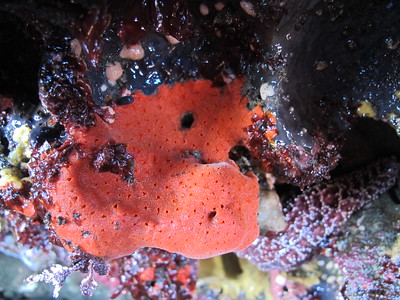These animals are more complicated than you might think.
 Sponges are actually colonies of one-celled individuals. There are several different types of cells in a sponge; one type has hairs that beat the water and move it though the holes of the body. Holes in the spongy layer allow water to circulate through the colony: tiny pores let water in and larger pores let water out, and canals connect the two. The individual cells feed on plankton and detritus in the water as it moves through the colony.
Sponges are actually colonies of one-celled individuals. There are several different types of cells in a sponge; one type has hairs that beat the water and move it though the holes of the body. Holes in the spongy layer allow water to circulate through the colony: tiny pores let water in and larger pores let water out, and canals connect the two. The individual cells feed on plankton and detritus in the water as it moves through the colony.
The channels and pores that circulate water through the colony also store water if the colony is exposed at low tide.
Our intertidal sponges are “encrusting,” and may grow over mussel shells and other hard surfaces, as well as over rock.
Certain nudibranchs and other grazing molluscs feed on sponges—in fact, a couple of our nudibranchs are the same color as the sponges they feed on. Look for a small, bright orange nudibranch on bright orange sponge.
Not surprisingly, our encrusting sponges are patches of slightly tough, spongy material that appears as if it were slathered on the rock and other hard surfaces, up to a quarter inch thick. The patches are irregular in shape and size, ranging from barely visible to areas larger than both your outstretched hands. Different species are different colors, with an astounding variety; different species vary in surface texture, too, from nearly-slick to rather tufted. There are tiny and larger pores in the spongy layer. In some species, such as the purple sponge in this photo, the larger pores are in the center of volcano- or nipple-shaped structures that protrude up to a quarter inch or more above the overall surface of the sponge. Some species are noted for the putrid smell they emit when crushed or rubbed.
Crawling molluscs, nudibranchs are shell-less snails that are sometimes called “sea slugs” because of their resemblance to land slugs. One of the most commonly encountered sea slugs in Oregon’s tidepools are lemon nudibranchs.
